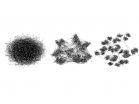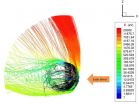(Press-News.org) The results of a prospective, randomized, placebo-controlled, double-blind trial of patients undergoing elective pulmonary resection was designed to evaluate the effects of statin therapy. Unfortunately, because of difficulties in enrolling patients who had never taken statins, the study was terminated early, and the sample size was smaller than anticipate. Trends in the data suggesting differences between groups failed to reach statistical significance except in a post-hoc analysis. The accompanying Editorial Commentary by Dr. Betty Tong emphasizes the potential importance of statins for reducing the morbidity associated with major thoracic surgery. The Expert Opinion contributed by Dr. Neel R. Sodha and Dr. Frank Sellke evaluates the evidence regarding the benefits of statins as an adjunctive therapy for cardiac and thoracic surgery.
Beverly, Mass., June 22 -- Statins have been shown to reduce complications from cardiovascular surgery. To determine whether statins might also help those undergoing major lung surgeries, a team at Memorial Sloan Kettering Cancer Center conducted a well-designed study that randomized patients to receive either a statin or placebo before and after surgery. They found that patients undergoing major lung resection experienced fewer complications overall, however, the differences between groups for specific complications or changes in inflammatory markers failed to reach statistical significance, according to a report in the Journal of Thoracic and Cardiovascular Surgery, the official publication of the American Association for Thoracic Surgery (AATS).
Because encouraging trends were observed, the authors have called for further evaluation in a larger multicenter, randomized, controlled trial. In an Editorial Commentary that accompanied the report, Betty C. Tong, M.D., of the Division of Cardiovascular and Thoracic Surgery of Duke University Medical Center (Durham, NC), concurred. 'Imagine all the people who could potentially have benefited from the knowledge gained by this trial had it accrued as originally intended. With continued enthusiasm and surgeon commitment to multicenter clinical trials, we will be able to elucidate further the role of therapies such as this in preventing complications after lung resection,' noted Tong.
The original study design called for 480 patients to be enrolled. In part because previously unpublished data on the efficacy of the statin (atorvastatin) to reduce postoperative atrial fibrillation were released soon after the trial began and it became challenging to find patients who were not taking the drug, only 164 patients were randomized into two groups.
Total postoperative complications occurred in 22 percent of patients receiving placebo and 12 percent patients receiving the statin. While the difference was not statistically significant, the composite of major pulmonary and cardiovascular complication rates in those who underwent more extensive surgeries (anatomic lung resections) were three-fold higher in placebo-treated patients than those who received the statin and the difference was statistically significant.
While other complications including pneumonia, acute respiratory failure, myocardial infarction, deep vein thrombosis, and mortality were more frequent in the placebo group compared to the statin group, the differences were not statistically significant. Postoperative rates of atrial fibrillation in the atorvastatin group were cut by almost half (from 27 to 14 percent), but the change, while perhaps clinically meaningful, was not statistically significant. In addition, no differences were found in plasma levels of markers of inflammation, such as C-reactive protein, tumor necrosis factor-α, or myeloperoxidase. 'These promising results in patients undergoing anatomic pulmonary resection merit further evaluation in a larger multicenter, randomized, controlled trial before recommendation as standard clinical practice,' explained lead author David Amar, M.D., of the Departments of Anesthesiology and Critical Care Medicine, and co-principal investigator Bernard Park, M.D., of the Department of Surgery at Memorial Sloan Kettering Cancer Center (New York).
In light of the increasing use of statins, including during the perioperative period for cardiac and thoracic surgery, and their low potential for adverse effects, Neel R. Sodha, M.D., and Frank W. Sellke, M.D., of the Division of Cardiothoracic Surgery of Alpert Medical School of Brown University (Rhode Island) prepared an Expert Review of the clinical evidence of perioperative statin use. 'A review of the research shows that slightly more than half the studies [done for cardiac surgery] support the anti-inflammatory effect of statins. Clinical studies are confounded because most patients proceeding to cardiac or thoracic surgery are receiving statins to reduce the progression of coronary artery disease. Therefore, it is difficult to know whether statins also reduce postoperative complications. Conclusions regarding the relationship of statins to clinical outcomes cannot be drawn based on current data,' stated Sodha and Sellke.
They point to wide variation among reports concerning the magnitude of the reduction in inflammatory parameters. Noting that the two trials (including that of Amar and colleagues) investigating the effect of statins in thoracic surgery produced discordant results, they concluded that 'this inconsistency lends more weight to the need for caution in using statins for the sole purpose of minimizing perioperative inflammation.'
INFORMATION:
The microbiome of the human intestine consists of a variety of bacteria that assist in digestion, immune regulation, and other processes that are critical for human health. A subset of these bacteria produces urease, an enzyme that converts the waste product urea into ammonia. Ammonia supports a variety of physiological process. However, individuals with liver disease have excess ammonia in the blood, a condition referred to as hyperammonemia, that can cause neurotoxicity and hepatic encephalopathy. Current treatments for hyperammonemia-associated symptoms are limited and ...
(Boston)-- A major treatment breakthrough for total body scarring of the skin that occurs in patients with systemic sclerosis (SSc), also known as scleroderma, may soon be available for the estimated 300,000 Americans who suffer with this condition. Currently, no treatment is available.
Boston University School of Medicine (BUSM) researchers worked with 15 SSc patients who were treated with either one or two doses of fresolimumab, a new, unapproved drug therapy that targets a chemical mediator in the body known as TGF-beta. After seven weeks of treatment, the researchers ...
DURHAM, N.C. -- Researchers have analyzed size data for rodents worldwide to distinguish the truly massive mice and giant gerbils from the regular-sized rodents. They found that the furry animals with chisel-like teeth are 17 times more likely to evolve to nightmarish proportions on islands than elsewhere.
The results are in keeping with an idea called the 'island rule,' which previous studies claimed didn't apply to rodents. The study appears online in the journal Proceedings of the Royal Society B.
Duke University biologists Paul Durst and Louise Roth analyzed data ...
PHILADELPHIA -- House calls, a long-running option dating back to the early days of medicine, can be used in a new way to improve geriatric care and lower costs, says a report issued last week from the Centers for Medicare and Medicaid Services (CMS).
Using first year results from Penn Medicine's Truman G. Schnabel In-Home Primary Care Program and its partners in the Mid Atlantic Consortium, Medstar Washington Hospital Center and Virginia Commonwealth University (VCU) along with the 16 other IAH practices nationwide, CMS announced last week more than $25 million was saved ...
For severely obese people, bariatric surgery may have a benefit besides dramatic weight loss: it can also substantially reduce urinary incontinence.
A new investigation led by UC San Francisco is the first to examine the longer-term effects of the surgical procedure on incontinence three years after bariatric surgery. The study appears online June 22 in JAMA Internal Medicine.
'Our findings showing another important long-term benefit to bariatric surgery might help to motivate people who are severely overweight,' said first author Leslee L. Subak, M.D., a UCSF professor ...
Somehow, colorful tropical scarlet macaws from tropical Mesoamerica -- the term anthropologists use to refer to Mexico and parts of northern Central America -- ended up hundreds of miles north in the desert ruins of an ancient civilization in what is now New Mexico.
Early scientists began excavating the large Pueblo settlements in Chaco Canyon in northwestern New Mexico and found the birds' remains in the late 1890s, but only recent radiocarbon dating of the physical evidence has pushed back the time period of sophisticated Pueblo culture by at least 150 years, according ...
Social networks affect every aspect of our lives, from the jobs we get and the technologies we adopt to the partners we choose and the healthiness of our lifestyles. But where do they come from?
In a new study, the University of Pennsylvania's Damon Centola shows how social networks form and what that means for the ideas that will spread across them.
Counterintuitively, he finds that breaking down group boundaries to increase the spread of knowledge across populations may ultimately result in less-effective knowledge sharing. Instead, his research shows that best ...
CORVALLIS, Ore. - A study at Oregon State University indicates that both a high-fat and a high-sugar diet, compared to a normal diet, cause changes in gut bacteria that appear related to a significant loss of "cognitive flexibility," or the power to adapt and adjust to changing situations.
This effect was most serious on the high-sugar diet, which also showed an impairment of early learning for both long-term and short-term memory.
The findings are consistent with some other studies about the impact of fat and sugar on cognitive function and behavior, and suggest that ...
If planets had personalities, Mars would be a rock star according to recent preliminary results from NASA's MAVEN spacecraft. Mars sports a "Mohawk" of escaping atmospheric particles at its poles, "wears" a layer of metal particles high in its atmosphere, and lights up with aurora after being smacked by solar storms. MAVEN is also mapping out the escaping atmospheric particles. The early results are being discussed at a MAVEN-sponsored "new media" workshop held in Berkeley, California, on June 19-21.
The Mars Atmosphere and Volatile Evolution (MAVEN) spacecraft was launched ...
COLUMBIA, Mo. - In 1964, renowned biologists Peter Raven and Paul Erhlich published a landmark study that introduced the concept of co-evolution. Using butterflies and plants as primary examples, the team determined that two species can reciprocally drive each other's evolution and development. Now, an international team of researchers led by the University of Missouri and Stockholm University has used cutting-edge genomics to analyze the co-evolution theory and identified the mechanisms responsible for this phenomenon. Scientists believe that understanding how co-evolution ...


